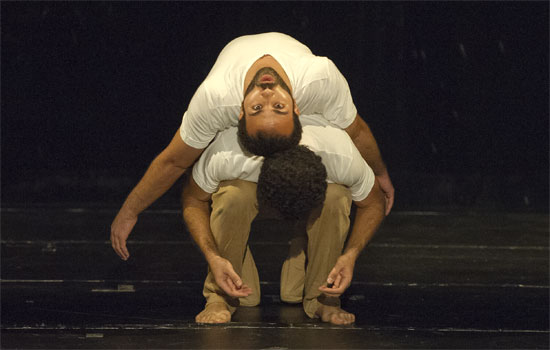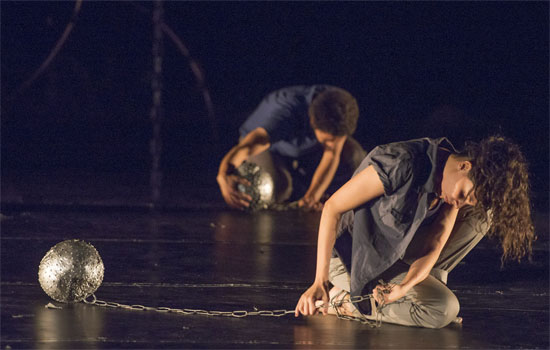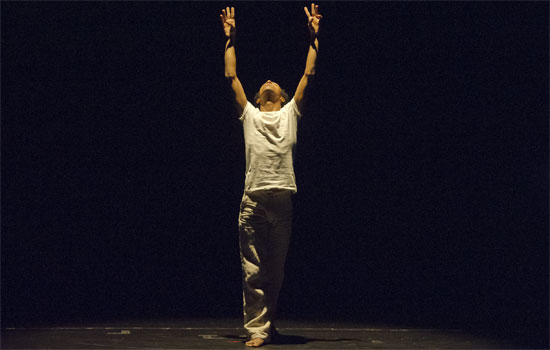Thursday 26 September witnessed the start of this year’s Contemporary Dance Night (CDN), the third edition of an independent initiative launched in 2011 by Ezzat Ismail Ezzat, an Egyptian performer and choreographer who founded his own studio, Ezzat Ezzat Contemporary Dance Studio, in 2012.
The event is scheduled to run until Tuesday 1 October in Downtown’s Falaki Theatre, and will be followed by a four-day workshop, from 3-6 October, where members of the audience with an interest in contemporary dance can receive a more thorough introduction to the art, and also engage in open discussions with the choreographers. CDN will then head to Alexandria for two more nights of performances in the Bibliotheca Alexandrina on 8 and 9 October.
According to the organisers, the aim of CDN is to familiarise the Egyptian public with contemporary dance and render it accessible to a larger number of spectators. A large number of dancers and choreographers participating in this year’s performances believe it is so far succeeding in doing so.
“The audience is more diverse now,” says Ahmed El-Gendy, a performer who took part in the previous editions and is also this year’s CDN media and public relations manager. “While the shows were initially mostly attended by people from the dance scene, or from artistic circles in general, we now have viewers from different backgrounds who have nothing at all to do with dance or art, which is great,” he adds.
El-Gendy, who has been dancing since 2008, thinks the last two years witnessed a relative increase in the popularity of contemporary dance in Cairo. “[The increase] is not directly related to the revolution, but perhaps the revolution played a role in breaking the barriers between people and certain types of art they had never been prompted to explore before; there’s also been a growing interest in the independent music and film scenes,” he says, “a newfound desire for self-expression was born and was translated into more spectators and more performers as well.”
Choreographer Mirette Mechail – founder and director of No Point Perspective dance/theatre group and participating with a number titled Everyone Is Sneakily Avoiding the Blue Lighter – has a different opinion. She believes a tangible surge of interest in contemporary dance can be traced back to years before CDN or the revolution.

'Everyone is Sneakily Avoiding the Blue Lighter' by Mirette Mechail; Contemporary Dance Night 2013 (Photo: Bassam Alzoghby)
“Contemporary dance in Egypt passed through several stages. It started with choreographers like Karima Mansour and Karim Tonsy, who were leading names on the modern dance scene, then began taking its current shape with the emergence of new choreographers like Reem Hegab and Mohamed Shafik, Adham Hafez, myself and now even more choreographers,” she elaborates.
Mechail thinks contemporary dance started becoming more accessible once it expanded beyond the walls of the Opera House and performances began to be held in other venues, thus attracting a different type of audience. “The turning point, perhaps, was almost five years ago, with the emergence of new experiments and a new generation of young dancers and choreographers. An improvement in the art form was apparent, and interest in it was no longer restricted to the same artistic circle.”
CDN, which started in 2011 with only two nights of performances in Rawabet Theatre, has now grown to span six nights in the larger, more accommodating Falaki Theatre, and to receive funding from several bodies including the British Council and the American Embassy in Cairo.
According to Ezzat, who first got the idea for the event after finishing the Cairo Contemporary Dance Workshop – which had taken place from 2008 to 2011 – there’s been a remarkable increase in the size of the audience. “We’re utterly shocked every day to see the amount of people lined up outside the theatre. So far it’s consistently been a full house,” he said; “this is not only thanks to CDN, but also to other initiatives seeking to acquaint people with contemporary dance, like Alexandria’s Nassim Al Raqs Festival.”
However, contemporary dance remains an elusive art and a controversial dance form. In Egypt, audiences often find themselves unable to relate to the performances for their lack of a solid narrative and absence of a consistent style or technique.
“The best and worst thing about contemporary dance is how open it is,” says Ezzat. “It’s liberating to have the space and freedom to express yourself in different ways using your body, but at the same time, that freedom is often taken advantage of in a negative way; it’s taken for a green-light to go overboard with the eccentricity, and that is when people cannot find anything in the performance that moves them.”

'Encounter' by Raafat El-Bayoumy; Contemporary Dance Night 2013 (Photo: Bassam Alzoghby)
Contemporary dance – the definition
“Contemporary dance cannot be narrowly defined,” says Mechail. “This year, for instance, we have very different kinds of performances – there’s Nagham Salah’s piece, which does have a bit of narrative,” she adds, “There’s also Hazem Header’s number, the second instalment of a trilogy he is working on.”
Salma Abdel Salam, one of the CDN dancers and a student at the Cairo Contemporary Dance Centre (CCDC), thinks the key to making the art accessible is in focusing on the dialogue aspect of contemporary dance instead of the ‘shock factor’. “But it’s still a very young art form and the scene is limited here in Egypt – in terms of performers and enthusiasts alike,” she says, “so we’re still figuring it out; it’s a work in progress.”
“The word ‘contemporary’ itself entails continuity and underlines the fact that it’s an ongoing process,” says Ezzat, “All over the world, contemporary dance is still evolving and has not yet reached its final stage. Therefore there can’t be one clear-cut, static definition for it.”
“We are still trying to find our own language when it comes to contemporary dance in Egypt; our own identity,” says Mechail. “Some choreographers have unfortunately copied and pasted Western approaches without real or sincere attempts at research, but others have been trying hard to find and maintain their own style,” she explains. “I believe Nadine Emile is one to watch out for; I think she is the best choreographer we currently have in Egypt, and the closest to creating a unique identity that can be distinguishable worldwide.”
Theatre director and choreographer Tamer Fathy, meanwhile, thinks it would be misleading to refer to the movement taking place in Egypt and being presented to the public through CDN as a contemporary dance movement.
“It’s like selling somebody a pack of cigarettes only for them to discover it’s actually a box of chocolates,” he says. “Of course the efforts of all the artists on the scene must be appreciated; they are working and giving their best under very tough conditions, but I don’t think it right to promote what they are doing as something it’s not.”

'Being Light' by Ibrahim Abdo; Contemporary Dance Night 2013 (Photo: Bassam Alzoghby)
Misconceived definition?
Some critics might think it more appropriate to place the current attempts in Egypt under the label of post-modern dance, a short-lived dance form that lasted in Europe and North America from the 1960s to the 1970s based on the philosophy that daily human movement is dance and every person who moves is a dancer.
Fathy – who was a student at the Higher Institute of Ballet for nine years, received a BA in choreography and later studied performing arts in London – rejects that notion. “I wouldn’t categorise it as any type of dance at all,” he says. “I do not know how to describe it myself, but I believe the need to find a new definition that doesn’t include the word ‘dance’ is crucial. It could be defined as some form of theatre, maybe; a type of personal expression that relies on extensive physical effort… but not dance,” he says.
Fathy was disappointed by some of the performances he attended this year. “Although I’m a choreographer myself, I can never tell who directed the piece I am watching, and this means the choreographers still lack individual style,” he says. “The themes they pick have also become very redundant and predictable.”
He believes that because the performances are always complicated, they do not contribute to popularising dance but in fact further alienate audiences. “They lack the joy that is so central to dance,” he explains. “There is nothing wrong with being entertaining; a show can be very deep and very entertaining as well. Art must be entertaining if it has any hope of garnering a following.”
Ibrahim Abdel Hameed, a dancer whom Fathy choreographed for one of the performances at a CCDC -hosted event in early 2013, participates in this year’s CDN with his choreographic debut titled Being Light. Although Fathy thinks the piece is good as a first work, he believes it should have been shorter. “That’s another thing about those performances; there is often no sense of time. You cannot expect people to sit down and watch you for 40 minutes, and actually enjoy themselves, if you won’t give them something that draws them in,” he says.
Yet Fathy believes it is cause for optimism that artists have the will and determination to work and create new initiatives despite all the challenges imposed on them. “Dancing isn’t easy anywhere in the world, least of all here,” he says. “It’s great that people are trying and experimenting; and I know they are working really hard. Maybe what they are doing right now is the seed of something bigger that is yet to emerge. One cannot possibly judge too harshly when the context itself is so restrictive.”
The challenges facing contemporary dance in Egypt are many, and they range from logistical obstacles – such as the lack of rehearsal spaces and performance venues, as well as shackling governmental bureaucracy – to cultural constraints due to people’s perception of dance in Egypt.
“The places where we can practice and perform are so few,” says El-Gendy, “and the events and performances are so sporadic that it’s very hard for dancers to rely on dancing alone to make ends meet; they always have to balance it out with another job.”

'Out of Synch' by Nagham Salah Othman; Contemporary Dance Night 2013 (Photo: Bassam Alzoghby)
Harsh realities and the future
The main problem, according to Mechail, is that there is no place contemporary dance aficionados can go in order to learn and become professional dancers. “Right now, if you can’t travel to study dance abroad, you either have to wait for the occasional workshop, or watch videos on YouTube,” she laments, “plus the government practically hates us; even the centre they gave us (CCDC) – which had been operating as a school – they now want to shut down.”
CCDC had been operating with dance designer Walid Aouni as its director until 2011. After the January 25 Revolution, activities were halted until 2012, then revived with leading choreographer Karima Mansour as artistic director this time and with a new three-year programme designed to equip students with the complete training to make professional dancers out of them. However, classes are now on hold again, as a result of a dispute between the staff and the Cultural Development Fund, which wants to turn the space – located at the Cairo Opera House grounds – into a larger project for ‘comprehensive artists’.
“The centre is not operating right now and we are still trying to figure out how and where we can continue the classes,” clarifies Abdel Salam, “It’s sad because the dance scene in Egypt is already too limiting,” she adds. “Even those who have managed to become well-established here would have exploded into something bigger and more magnificent had they been working abroad.”
To more traditional circles in Egyptian society, the body remains a taboo, and therefore dance as an art form and as a profession is often frowned upon. “I don’t think dancing could ever be as socially accepted in Egypt as other arts like music or film,” says Mechail, “We need at least 20 years of ceaseless work, without somebody following us with a sledgehammer tearing down everything we manage to build as we step forward.”
“I think dance is culturally not accepted in many places around the world; the decisive factor in how socially popular it becomes is the amount of government support it receives – and we have none,” says Ezzat, “so, yes, it’s undoubtedly hard, but I think of it like driving a car on a dark road where you can only see as far as the headlights allow you; I cannot predict the future, but if we take it one step at a time, doing the best we can with whatever resources we have, I believe we’re going to get somewhere.”

'Circuit' by Dalia El-Abd; Contemporary Dance Night 2013 (Photo: Bassam Alzoghby)
Short link: